2014 FORD F250 SUPER DUTY belt
[x] Cancel search: beltPage 23 of 460

2. Slide the tongue up the webbing.
3. While holding both shoulder and lapportions next to the tongue, route thetongue and webbing through the childseat according to the child seatmanufacturer's instructions. Be surethat the belt webbing is not twisted.
4. Insert the belt tongue into the properbuckle (the buckle closest to thedirection the tongue is coming from)for that seating position until you heara snap and feel the latch engage. Makesure the tongue is latched securely bypulling on it.
5.While pushing down with your knee onthe child seat pull up on the shoulderbelt portion to tighten the lap beltportion of the combination lap andshoulder belt.
6. Allow the safety belt to retract andremove any slack in the belt to securelytighten the child safety seat in thevehicle.
7.Attach the tether strap (if the child seatis equipped).
20
Super Duty (TFA)
Child SafetyE162708 E142530 E142531 E142533 E142534
Page 24 of 460

8. Before placing the child in the seat,forcibly move the seat forward andback to make sure the seat is securelyheld in place. To check this, grab theseat at the belt path and attempt tomove it side to side and forward andback. There should be no more than 1inch (2.5 centimeters) of movementfor proper installation.
9.Check from time to time to be sure thatthere is no slack in the lap and shoulderbelt. The shoulder belt must be snugto keep the lap belt tight during a crash.
Ford recommends checking with a NHTSACertified Child Passenger SafetyTechnician to make certain the childrestraint is properly installed. In Canada,check with your local St. John Ambulanceoffice for referral to a Child PassengerSafety Technician.
Using Lower Anchors and Tethersfor CHildren (LATCH)
The LATCH system is composed of threevehicle anchor points: two lower anchorslocated where the vehicle seatback andseat cushion meet (called the seat bight)and one top tether anchor located behindthat seating position. Your vehicle is notequipped with the lower anchor points inthe seat bight. For this vehicle, use thevehicle safety belt and upper tether tosecure a child seat.
Using Tether Straps
Many forward-facing child safety seatsinclude a tether strap which extends fromthe back of the child safety seat and hooksto an anchoring point called the top tetheranchor. Tether straps are available as anaccessory for many older safety seats.Contact the manufacturer of your childseat for information about ordering atether strap, or to obtain a longer tetherstrap if the tether strap on your safety seatdoes not reach the appropriate top tetheranchor in the vehicle.
The passenger seats of your vehicle maybe equipped with built-in tether strapanchors located behind the seats asdescribed below.
The tether anchors in your vehicle may bestraps on the seat back or an anchorbracket mounted to the body shell on theback panel.
The SuperCab rear seat has three strapsbehind the top of the seatback thatfunction as both routing loops for thetether straps and anchor loops.
The tether strap anchors in your vehicleare in the following positions (shown fromtop view):
21
Super Duty (TFA)
Child SafetyE162709
Page 25 of 460
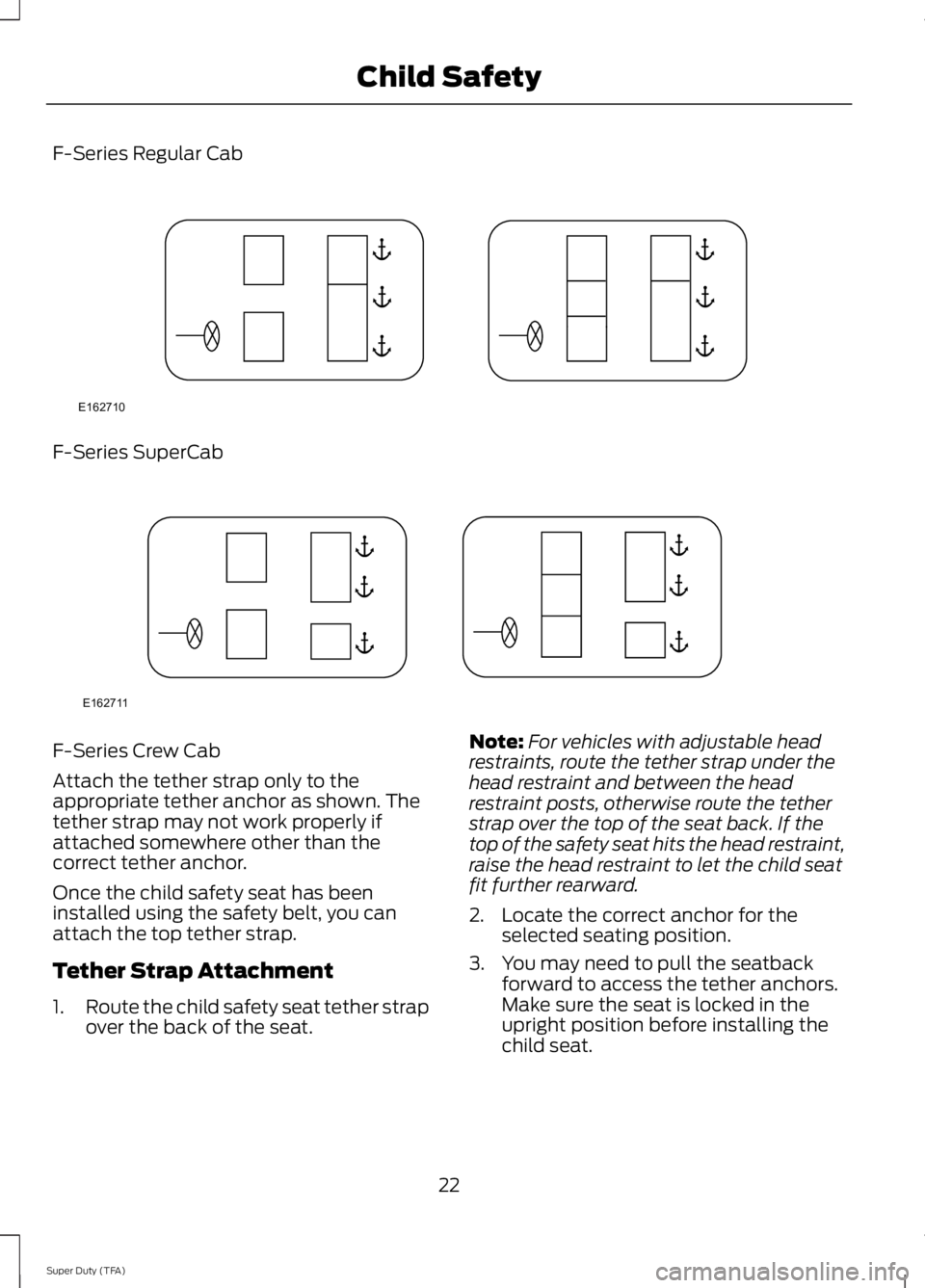
F-Series Regular Cab
F-Series SuperCab
F-Series Crew Cab
Attach the tether strap only to theappropriate tether anchor as shown. Thetether strap may not work properly ifattached somewhere other than thecorrect tether anchor.
Once the child safety seat has beeninstalled using the safety belt, you canattach the top tether strap.
Tether Strap Attachment
1.Route the child safety seat tether strapover the back of the seat.
Note:For vehicles with adjustable headrestraints, route the tether strap under thehead restraint and between the headrestraint posts, otherwise route the tetherstrap over the top of the seat back. If thetop of the safety seat hits the head restraint,raise the head restraint to let the child seatfit further rearward.
2. Locate the correct anchor for theselected seating position.
3. You may need to pull the seatbackforward to access the tether anchors.Make sure the seat is locked in theupright position before installing thechild seat.
22
Super Duty (TFA)
Child SafetyE162710 E162711
Page 27 of 460
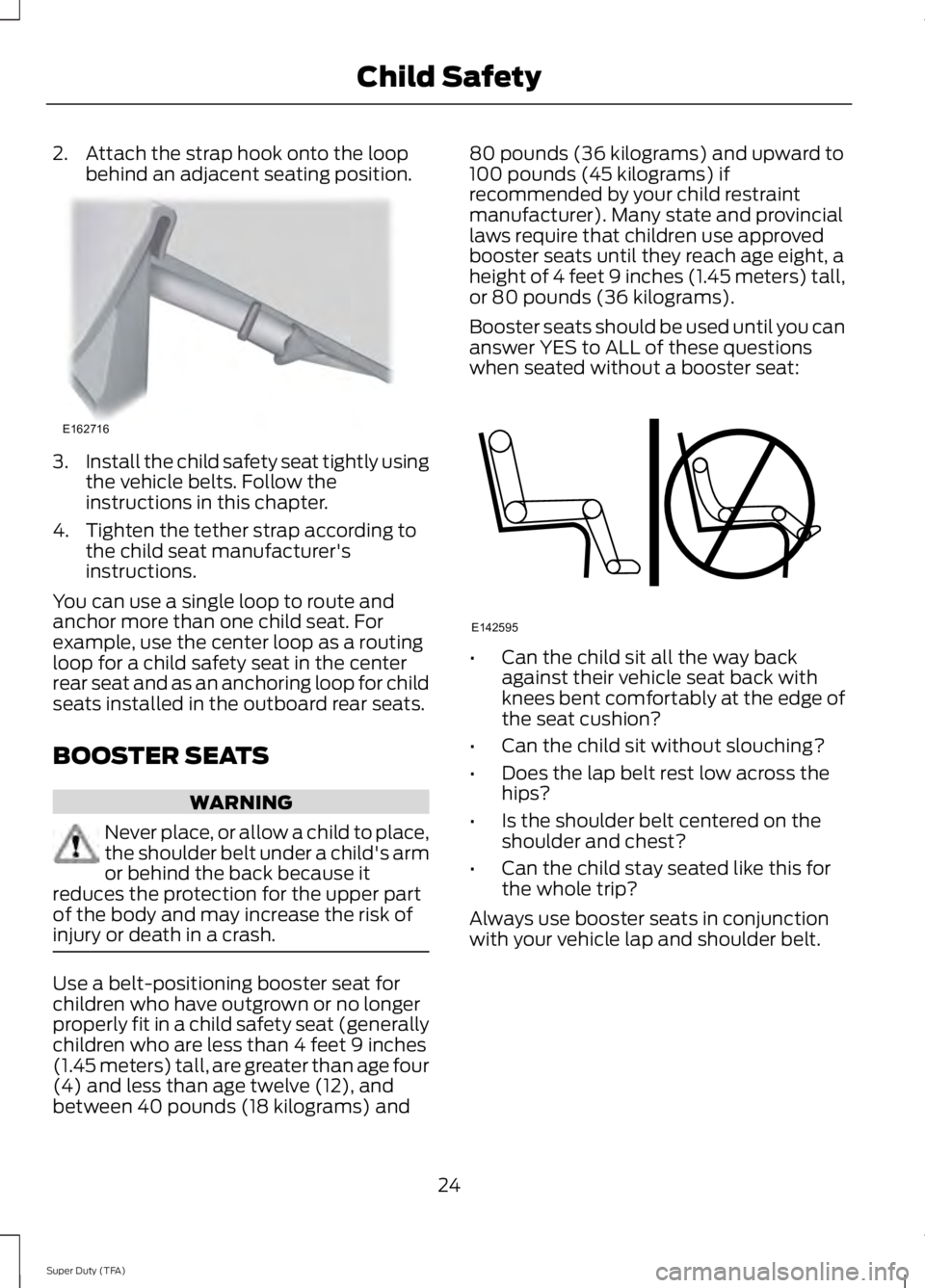
2. Attach the strap hook onto the loopbehind an adjacent seating position.
3.Install the child safety seat tightly usingthe vehicle belts. Follow theinstructions in this chapter.
4. Tighten the tether strap according tothe child seat manufacturer'sinstructions.
You can use a single loop to route andanchor more than one child seat. Forexample, use the center loop as a routingloop for a child safety seat in the centerrear seat and as an anchoring loop for childseats installed in the outboard rear seats.
BOOSTER SEATS
WARNING
Never place, or allow a child to place,the shoulder belt under a child's armor behind the back because itreduces the protection for the upper partof the body and may increase the risk ofinjury or death in a crash.
Use a belt-positioning booster seat forchildren who have outgrown or no longerproperly fit in a child safety seat (generallychildren who are less than 4 feet 9 inches(1.45 meters) tall, are greater than age four(4) and less than age twelve (12), andbetween 40 pounds (18 kilograms) and
80 pounds (36 kilograms) and upward to100 pounds (45 kilograms) ifrecommended by your child restraintmanufacturer). Many state and provinciallaws require that children use approvedbooster seats until they reach age eight, aheight of 4 feet 9 inches (1.45 meters) tall,or 80 pounds (36 kilograms).
Booster seats should be used until you cananswer YES to ALL of these questionswhen seated without a booster seat:
•Can the child sit all the way backagainst their vehicle seat back withknees bent comfortably at the edge ofthe seat cushion?
•Can the child sit without slouching?
•Does the lap belt rest low across thehips?
•Is the shoulder belt centered on theshoulder and chest?
•Can the child stay seated like this forthe whole trip?
Always use booster seats in conjunctionwith your vehicle lap and shoulder belt.
24
Super Duty (TFA)
Child SafetyE162716 E142595
Page 28 of 460
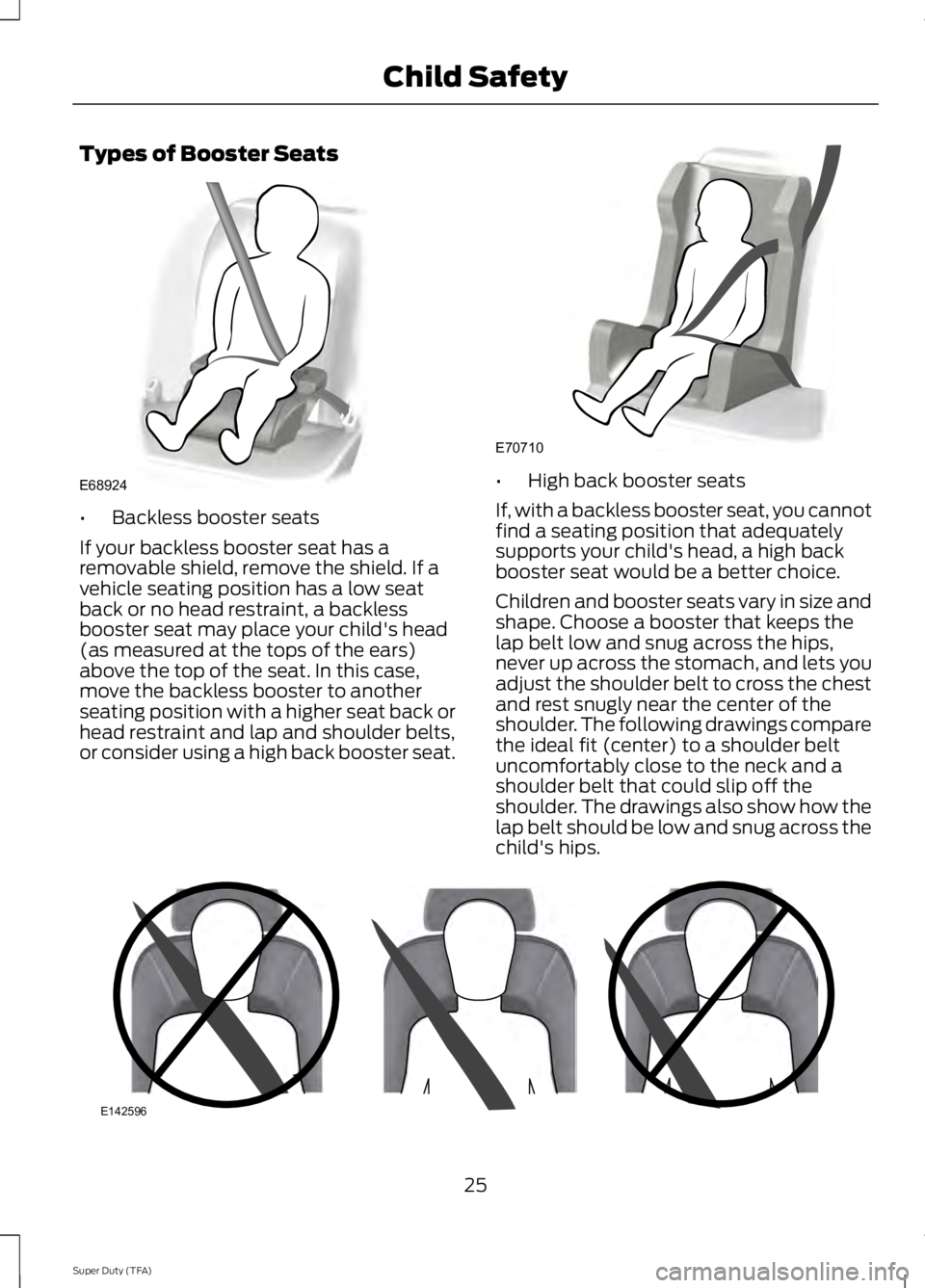
Types of Booster Seats
•Backless booster seats
If your backless booster seat has aremovable shield, remove the shield. If avehicle seating position has a low seatback or no head restraint, a backlessbooster seat may place your child's head(as measured at the tops of the ears)above the top of the seat. In this case,move the backless booster to anotherseating position with a higher seat back orhead restraint and lap and shoulder belts,or consider using a high back booster seat.
•High back booster seats
If, with a backless booster seat, you cannotfind a seating position that adequatelysupports your child's head, a high backbooster seat would be a better choice.
Children and booster seats vary in size andshape. Choose a booster that keeps thelap belt low and snug across the hips,never up across the stomach, and lets youadjust the shoulder belt to cross the chestand rest snugly near the center of theshoulder. The following drawings comparethe ideal fit (center) to a shoulder beltuncomfortably close to the neck and ashoulder belt that could slip off theshoulder. The drawings also show how thelap belt should be low and snug across thechild's hips.
25
Super Duty (TFA)
Child SafetyE68924 E70710 E142596
Page 29 of 460
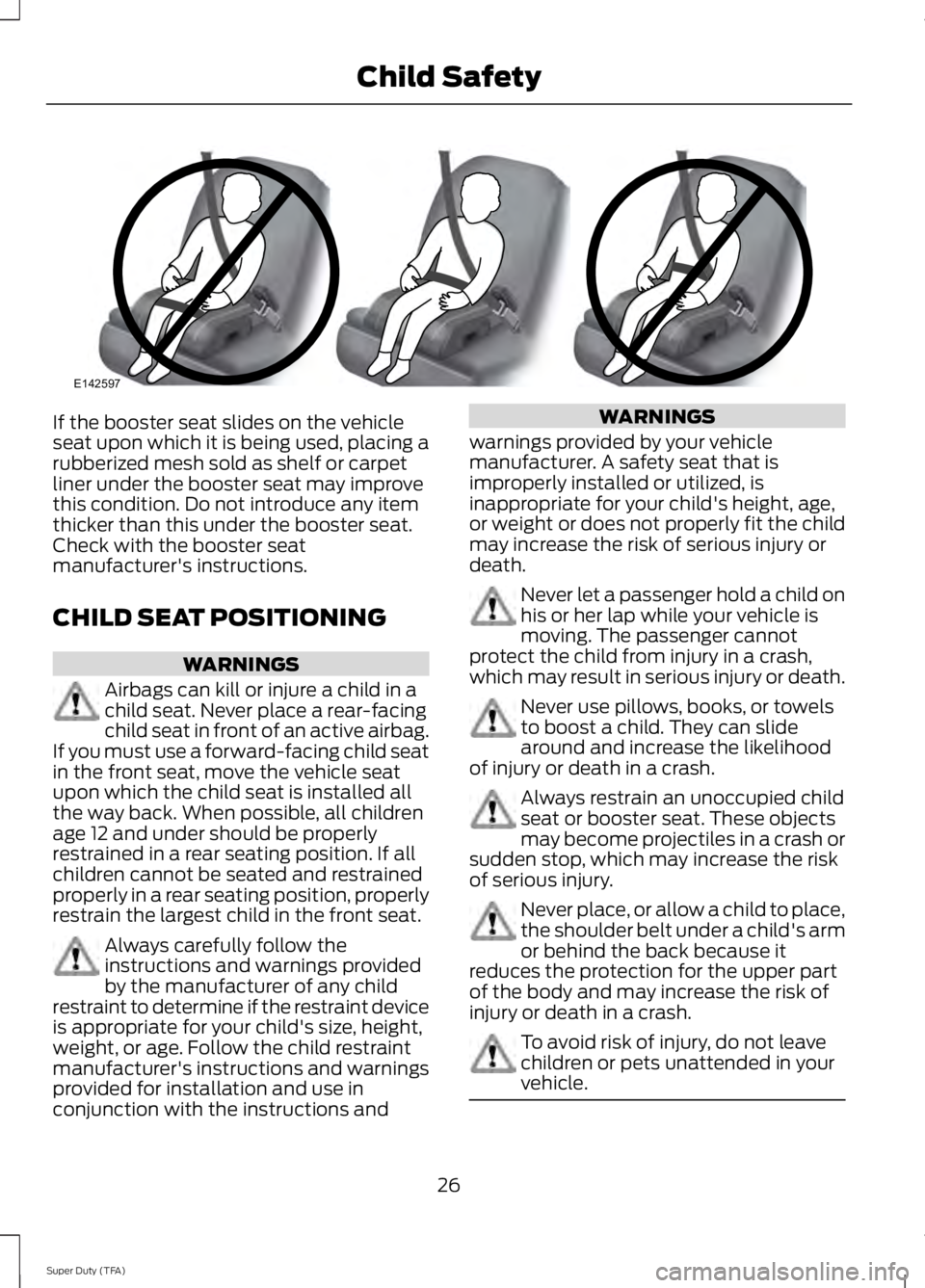
If the booster seat slides on the vehicleseat upon which it is being used, placing arubberized mesh sold as shelf or carpetliner under the booster seat may improvethis condition. Do not introduce any itemthicker than this under the booster seat.Check with the booster seatmanufacturer's instructions.
CHILD SEAT POSITIONING
WARNINGS
Airbags can kill or injure a child in achild seat. Never place a rear-facingchild seat in front of an active airbag.If you must use a forward-facing child seatin the front seat, move the vehicle seatupon which the child seat is installed allthe way back. When possible, all childrenage 12 and under should be properlyrestrained in a rear seating position. If allchildren cannot be seated and restrainedproperly in a rear seating position, properlyrestrain the largest child in the front seat.
Always carefully follow theinstructions and warnings providedby the manufacturer of any childrestraint to determine if the restraint deviceis appropriate for your child's size, height,weight, or age. Follow the child restraintmanufacturer's instructions and warningsprovided for installation and use inconjunction with the instructions and
WARNINGS
warnings provided by your vehiclemanufacturer. A safety seat that isimproperly installed or utilized, isinappropriate for your child's height, age,or weight or does not properly fit the childmay increase the risk of serious injury ordeath.
Never let a passenger hold a child onhis or her lap while your vehicle ismoving. The passenger cannotprotect the child from injury in a crash,which may result in serious injury or death.
Never use pillows, books, or towelsto boost a child. They can slidearound and increase the likelihoodof injury or death in a crash.
Always restrain an unoccupied childseat or booster seat. These objectsmay become projectiles in a crash orsudden stop, which may increase the riskof serious injury.
Never place, or allow a child to place,the shoulder belt under a child's armor behind the back because itreduces the protection for the upper partof the body and may increase the risk ofinjury or death in a crash.
To avoid risk of injury, do not leavechildren or pets unattended in yourvehicle.
26
Super Duty (TFA)
Child SafetyE142597
Page 30 of 460

Use any attachment method as indicated below by XCombinedchild andseatweight
RestraintTypeSafety beltonlySafety beltand LATCH(loweranchorsand toptetheranchor)
Safety beltand toptetheranchor
LATCH(loweranchorsonly)
LATCH(loweranchorsand toptetheranchor)
XUp to 65 lb(29 kg)Rear facingchild seat
XOver 65 lb(29 kg)Rear facingchild seat
XUp to 65 lb(29 kg)Forwardfacingchild seat
XOver 65 lb(29 kg)Forwardfacingchild seat
Note:The child seat must rest tightlyagainst the vehicle seat upon which it isinstalled. It may be necessary to lift orremove the head restraint. See HeadRestraints (page 108).
CHILD SAFETY LOCKS
When these locks are set, the rear doorscannot be opened from the inside.
The childproof locks are located on therear edge of each rear door. You must setthe lock separately for each door.
Move the lock control up or down toengage or disengage the childproof lock.
27
Super Duty (TFA)
Child SafetyE162719
Page 31 of 460
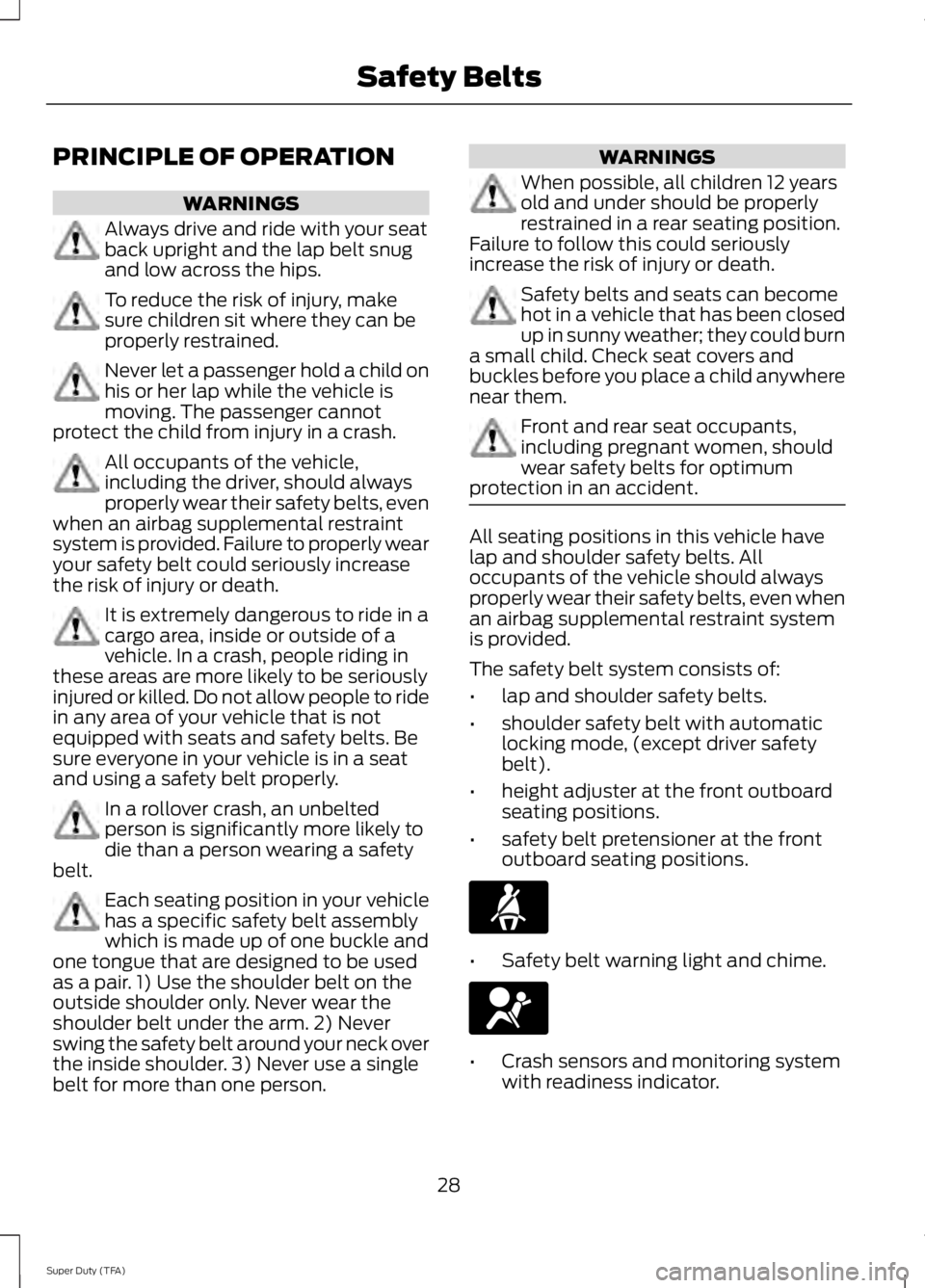
PRINCIPLE OF OPERATION
WARNINGS
Always drive and ride with your seatback upright and the lap belt snugand low across the hips.
To reduce the risk of injury, makesure children sit where they can beproperly restrained.
Never let a passenger hold a child onhis or her lap while the vehicle ismoving. The passenger cannotprotect the child from injury in a crash.
All occupants of the vehicle,including the driver, should alwaysproperly wear their safety belts, evenwhen an airbag supplemental restraintsystem is provided. Failure to properly wearyour safety belt could seriously increasethe risk of injury or death.
It is extremely dangerous to ride in acargo area, inside or outside of avehicle. In a crash, people riding inthese areas are more likely to be seriouslyinjured or killed. Do not allow people to ridein any area of your vehicle that is notequipped with seats and safety belts. Besure everyone in your vehicle is in a seatand using a safety belt properly.
In a rollover crash, an unbeltedperson is significantly more likely todie than a person wearing a safetybelt.
Each seating position in your vehiclehas a specific safety belt assemblywhich is made up of one buckle andone tongue that are designed to be usedas a pair. 1) Use the shoulder belt on theoutside shoulder only. Never wear theshoulder belt under the arm. 2) Neverswing the safety belt around your neck overthe inside shoulder. 3) Never use a singlebelt for more than one person.
WARNINGS
When possible, all children 12 yearsold and under should be properlyrestrained in a rear seating position.Failure to follow this could seriouslyincrease the risk of injury or death.
Safety belts and seats can becomehot in a vehicle that has been closedup in sunny weather; they could burna small child. Check seat covers andbuckles before you place a child anywherenear them.
Front and rear seat occupants,including pregnant women, shouldwear safety belts for optimumprotection in an accident.
All seating positions in this vehicle havelap and shoulder safety belts. Alloccupants of the vehicle should alwaysproperly wear their safety belts, even whenan airbag supplemental restraint systemis provided.
The safety belt system consists of:
•lap and shoulder safety belts.
•shoulder safety belt with automaticlocking mode, (except driver safetybelt).
•height adjuster at the front outboardseating positions.
•safety belt pretensioner at the frontoutboard seating positions.
•Safety belt warning light and chime.
•Crash sensors and monitoring systemwith readiness indicator.
28
Super Duty (TFA)
Safety Belts